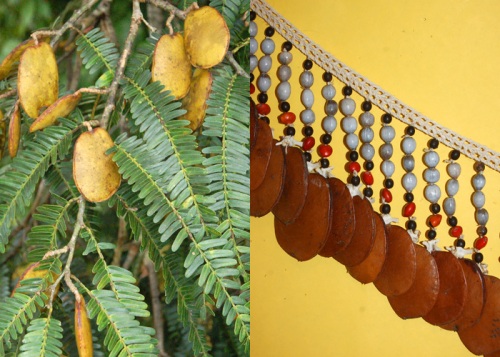
Bora girl Mari steering peque-peque and huitillo fruits on Yaguasyacu River. Photos by Campbell Plowden/CACE
With our gear and bag full of handicrafts loaded in the boat, Yully and I headed downriver with Beder at the helm of a peque-peque with his daughter Mari as his co-pilot. The clear afternoon gave me a chance to get a close look at a couple of plants used in crafts that I hadn’t seen before in nature. Beder first steered us to a “huitillo,” a tree that can survive immersion of its lower section for months. Artisans collect its golf ball sized fruits during the rainy season to dye chambira palm fibers a dark grey-black.

Paschaco fruit on Yaguasyacu River and Bora ceremonial belt made from paschaco seeds. Photos by Campbell Plowden/CACE
Farther along we came to a “pashaco” tree full of yellow kidney shaped pods whose flat coffee-colored seeds are often strung together to make a ceremonial belt for young women coming of age. The most distinctive plant of the afternoon was a vine with a bright orange curved spike flower hanging near the entrance to a sacarita (river loop short-cut). I had just begun to inspect it when Beder warned me not to touch it because it makes the skin very itchy. He called this slender phallic-like plant “patikina” – coincidentally the same name as a discotheque in Pebas.
We cruised by the entrance to Nueva Esperanza just after 5 pm but didn’t stop this time. When she passed by here last September Yully told me she had spotted a “bufeo” (pink Amazon river dolphin) floating in the river. She had occasionally seen a dolphin snarled in a fishing net, but this one seemed unharmed. Her concern grew when she saw three more dead bufeos along this section of the Yaguasyacu and Ampiyacu. There were no dead fish to provide any clues, so the cause of the dolphins’ untimely fate remained a mystery.
By the time we got to Puca Urquillo it was already dusk. We set up our craft receiving operation on the sidewalk in front of Cherly’s house to take advantage of the remaining light. The women had done a nice job of putting the final touches on their ornaments. As I attached tags to the items and waited for Yully to pay them, the women stomped their feet and slapped their arms in a sort of jerky dance that is common at this time when mosquitoes seek their evening meal.

Ceremonial mask made of wingo fruit pod by Bora artisan at Puca Urquillo. Photo by Campbell Plowden/CACE
We returned to the other side of the village to pick up some crafts from a few Bora artisans. We gathered at Elsa’s house where I saw the full range of her husband’s talent turning “wingos” (calabash fruits) into masks and human figures. I learned these pods didn’t need to be dyed because once picked, their green outer shell naturally darkened to a lustrous black. As he casually guided a fine curved chisel over a small one, a frog with a smart-aleck grin emerged within two minutes. Since he had mastered his art over many years, I was impressed that the women artisans had done so well carving our ornaments in their first attempts.

Yagua artisans Mariela and Guillermina with crafts at San Jose de Piri. Photos by Campbell Plowden/CACE
Returning to Pebas, we stored our bags in a hotel near the port and walked up to San José de Piri where Mariela showed us a small traditional Yagua figure she had made as a trial ornament for us. Her mother-in-law Guillermina showed us a chambira bag with an unusual marbled blend of colored figures. The work wasn’t ready for prime time, but it was good to feel like we finally had some place to start in this oft-forgotten indigenous community.
I had hoped to return to Iquitos on one of the “rapidos,” a boat with a powerful outboard engine that can deliver 20 passengers from Pebas to the city in less than five hours. These only run a few times a week, though, so we relaxed for dinner at Pebas’ best (and perhaps only) “polleria” (broiled chicken is only item on the menu) with Beder and Mari. I don’t expect fine dining in the hinterlands, but I was disappointed that a nice restaurant started by the wife of Pebas’ reknowned painter Grifa had barely lasted six months. I guessed it was too pricey for local folks and not enough tourists came through town to make it a viable business.
Our hotel had the bare basics – a bed with a thin mattress, a small table and chair, one light bulb hanging from the ceiling that worked until power went off in the town at 11 pm. I took a bucket bath with cold water in the public bathroom hoping no one would walk in since there was neither lock nor latch. I slept fine until the rooster tied to a post near some plastic jugs and generator in a back storage area next to my room began crowing with distant fellow foul around 4:30 a.m. This inspired unhumane fantasies and the certain knowledge that writing a negative review about this quirky bit of hospitality on Facebook would have no impact.
I read a little, packed and was ready to go when the motel owner knocked on Yully’s and my doors just after dawn to let us know that a boat was approaching. We hustled to the port and saw that two lanchas coming from the Brazilian frontier had just landed. Both boat reps were yelling out lower and lower prices to attract passengers to Iquitos in the hammock class. The competition also benefited Yully and me since we easily got a camarote (small cabin) where we could store our bags without fear of midnight theft.

Huitoto artisan Cherly Flores with armadillo ornament at Puca Urquillo. Photo by Campbell Plowden/CACE
Yully and I had a peaceful and productive day to chat, assign numbers to new models and put tags on every craft. We bought popcorn, aguaje popsicles, fried fish, and Bimbo lemon soda from vendors that flooded onto the boat at towns like Oran along the way – stops that seemed to occur shortly before a crewmember from the boat came around with free plates of spaghetti, rice and chicken. I got a few hours of sleep in my top bunk before we docked around 1 a.m. at the “muelle” – a special dock where customs inspect boats coming from Brazil. Yully has had agents search every corner of her bags on a few trips. They cleared our vessel quickly this time after checking the ship’s paperwork. I made it back to the Hotel Marañon in Iquitos around 2:30 a.m. and gratefully crashed in a comfortable bed after spending about 48 hours of the previous three days within earshot of boat engines large and small.





